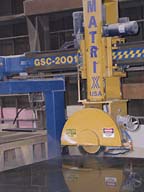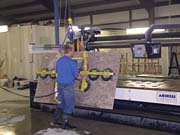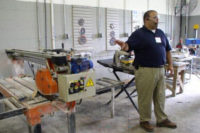

Each employee has the responsibility to comply with safety rules and regulations, to protect equipment, to report and resolve unsafe conditions, and to avoid unsafe behavior.
Every shop and contractor should appoint a safety director responsible for the implementation of the company's safety program. The most important aspect of any safety policy or program is its implementation.
Every shop and contractor should appoint a safety director responsible for the implementation of the company's safety program. The director's responsibilities should include, but not be limited to, the following: safety training; procedural instructions; first
aid and medical access; hazard communications; emergency procedures; equipment malfunctions; safety audits; instruction on personal protection equipment; hearing testing; electrical safety; respiratory protection program; workplace hazards.
I. Personal protective equipment
The Marble Institute of America recommends that member firms establish a company policy that all employees comply with OSHA standards regarding personal protectice equipment. Violations should be subject to discipline as set by the company's structure.
- When operating saws, routers, and any other shop equipment, all employees must wear safety glasses with side shields and earplugs or muffs.
- When operating machinery where an employee will be standing in water, properly fitting rubber boots and gloves must be worn. Tennis shoes or similar footwear are not suitable.
- Long pants and comfortable long sleeve or short sleeve shirts must be worn at all times.
- When working with dry cutting, shaping, etc., a properly fitting respirator must be worn at all times.
- Any personal protective equipment that is found to be defective should be replaced immediately.
II. Electrical safety
- Only trained and authorized personnel are permitted to service electrical equipment.
- Safety devices which have been installed on equipment such as interlocks, covers, ground fault circuit interrupters (GFCIs), etc., are for the protection of all employees and are not to be circumvented.
- Read and follow the equipment manufacturer's recommendations on the safe use of all equipment.
- Ground leads on cords and equipment must be checked routinely as part of the ground-assurance program or GFCIs must be used on all equipment.
- Do not operate electrical equipment while standing on metal, in water or on wet floors. This is difficult to avoid in the stone shop, so be sure to wear rubber boots and gloves and make sure all equipment is properly connected to a GFCI.
- Water must be kept off all electrical equipment. Avoid getting dirt or water into vents of air-cooled motors.
III. Hazard communications
In 1988, OSHA passed a regulation that requires all employers to inform their employees about any hazardous materials they might come in contact with on the job. All the employers are required to have such a program in written form.
The following materials used in most stone shops are considered hazardous materials:
- Solvents-acetone, alcohol, MEK, etc.
- Polyesters and epoxies
- Sealers and impregnators
- Polishing powders
- Shellac
- Glues
- Gasoline and diesel fuel
- Hydraulic oil and other oils
- Granite and marble slurry
- Granite and marble dust
Employees have the right to know what hazards they may face on the job, and they have the right to be trained on how to protect themselves against any hazardous materials in the workplace. An employee cannot be fired or discriminated against because he or she asks for information and training on how to handle the hazardous materials in the workplace.
There are two primary sources of information on hazardous materials: Material Safety Data Sheets (MSDS) and product labeling. Employees should review this information prior to using hazardous materials and follow the recommended safe handling procedures and protective equipment requirements.
MSDS provide the following information: chemical identification, hazardous ingredients, physical data, fire and explosion data, health hazards, reactivity, spill and leak procedures, special protection; and special precautions. (Note: The Marble Institute of America's publication, "How to Prepare Material Safety Data Sheets" provides instructions on preparing MSDS for stone.)
Hazard communication information should be posted in the workplace indicating where the MSDS are located and must be accessible to all employees.
IV. Respiratory protection
The purpose of respiratory protection is to control occupational diseases caused by breathing air contaminated with harmful dust, fogs, fumes, mists, gases, smokes, sprays or vapors. Granite cut and worked dry will create a silicate dust, which is harmful to workers. Marble dust is considered a nuisance dust and can cause breathing problems for those with respiratory problems. The purpose of this guideline is to prevent or minimize worker exposure to these and other airborne contaminants through the use of accepted engineering control measures such as dust control equipment, general and local ventilation, etc. When effective engineering controls are not feasible, or while they are being installed, appropriate respirators should be used.
A. Work practices
Recognize where silica dust may be generated and plan ahead to eliminate dust at the source. The best industrial ventilation system or any other type of well-engineered system designed to improve the working environment and reduce the amount of dust generated can easily be defeated by poor work practices of the employees. It is very important when a dust-control program is initiated in a fabricating plant or at a job site that the work practices of each employee be analyzed. The key to making employees "dust conscious" is information and training.
B. Housekeeping
Housekeeping is the most important of all dust control methods. Simply cleaning up all possible emission sources as quickly as possible is the most effective dust suppression technique. Practices such as vacuuming and wet floor cleaning prevent high dust levels and improve already clean environments. These two methods will reduce dust by 50% to 75%. Because these cleaning methods are labor intensive rather than capital intensive, they can easily be used at both the stone shop and the construction site.
C. Personal hygiene
Do not eat, drink or use tobacco in areas where there is dust containing crystalline silica. Wash hands thoroughly prior to eating. Consider changing into disposable or washable work clothes at the job site. Shower (where available) and change into clean clothing before leaving the job site to prevent contamination of cars, homes and other areas.
D. Provision and application
E. Selection of respirators
- Respirators shall be selected from among those approved by the National Institute for Occupational Safety and Health (NIOSH) under the provisions of 30 CRF part 11.
- There are three steps involved in the selection of respiratory protective equipment: identification of the hazard; evaluation of the hazard; selection of the appropriate approved respiratory equipment based on the findings of the first two steps.
- At the beginning of a project, the project supervisor and the safety director or designee will identify and evaluate hazards in the work area.
- The type and level of contaminants identified along with recommended respirators will be documented and, if required, contained within a written site-specific safety program.
F. Medical examination
- Only employees who are physically able to perform the work while using respiratory protection will be assigned tasks requiring the use of respirators.
- The employer's physician or designated healthcare professional shall determine what health and physical conditions are pertinent and approve respirator use.
- The respirator user's medical status will be reviewed annually.
G. Use and fit testing
The competent person in the selection of use and maintenance of respirators will properly instruct supervisor and workers. Training should cover:
a. Types of hazards and specifics of those hazards
b. Type of respirator selected to protect against the hazard
c. Train the employee how to put on the respirator
d. Train the employee on the various components of the respirator and how the respirator functions to remove contaminants
e. Proper fitting of the respirator
f. Limitations on the usage of the respirator
g. Maintenance and cleaning of the respirator
h. Inspection of defects
Employees who will be using negative pressure respirators shall be fit tested by a qualified individual. Many suppliers who sell respirators can fit test. A record of this test shall be kept and filed with the corporate office. The fit test will be performed at least annually or whenever there is a reason to suspect the adequacy of the respirator seal on a particular employee, for example, weight gain or loss or any serious injury to the face or jaw. Wearing contact lenses while using a respirator shall not be allowed. The safety director or designee will conduct frequent random inspections to assure that respirators are properly selected, used, cleaned and maintained.
H. Cleaning respirators
- Routinely used respirators will be collected, cleaned and disinfected as frequently as necessary to insure that proper protection is provided for the wearer. Respirators maintained for emergency use shall be cleaned and disinfected after each use.
- Respirators used by more than one employee will be cleaned and disinfected after each use.
- The safety director or designee will be responsible for monitoring the cleaning and disinfecting procedure.
- The cleaned respirator should be stored in a resealable plastic bag, one per bag. The respirator should be stored in a single layer in such a manner as to prevent the rubber or plastic parts of the face piece from being distorted.
- The respirator should be protected from dust, sunlight, heat, extreme cold, excessive moisture, damaging chemicals and mechanical damage.
I. Inspection and Maintenance
- All respirators shall be inspected before and after each use and during cleaning.
- A designated qualified employee, with the aid of the manufacturer's literature and parts, can perform replacement of parts on air-purifying respirators. Replacement parts for respirators must be those of the manufacturer, and substitutions of parts from a different brand or type of respirator will invalidate the approval of the respirator.
- Self-Contained Breathing Apparatus (SCBA) equipment must be returned to the manufacturer for repairs and adjustments.
- Respirator inspection shall include a check of tightness of connections and the condition of the face piece, headbands, valves, connection tube and canisters. Rubber or elastomer parts will be inspected for pliability and signs of deterioration. Stretching and manipulating rubber or elastomer parts with massaging action will keep them pliable and flexible in storage.
- A record shall be kept of inspection dates.
J. Employee training
- Employees will be trained on the use, care and hazards associated with the use of the respirators prior to work assignments where respiratory equipment is repaired.
- Training will be conducted at least annually. If the employee has not used the equipment in more than six months, then retraining will be required.
- Training will be documented and include employee's name, date of training and type of respirator trained on.
V. Equipment operation procedures
A. Saws
- The owner shall provide an instruction manual, keep proper maintenance records, provide a device to measure blade RPM or list the arbor RPM on fixed speed saws, and see to it that all operators have proper personal safety and protective equipment for operating the saw.
- Each operator must fully read and understand the instruction manual for any saw to be operated, and be familiar with all aspects of machine operation, including being familiar with all machine controls and functions.
- The operator must also make sure the blade shaft RPM is proper for the size of the blade being used.
- The operator must not operate any saw that is unsafe, and may never leave the machine running unattended unless the machine is factory-equipped to operate without an attendant.
- When operating any saw, safety glasses, proper footwear, hearing protection and head protection are required.
- Never operate or allow anyone to operate equipment when tired or under stress or while under the influence of drugs, alcohol or medications which impair alertness or reaction time.
- Do not operate while wearing loose-fitting clothing. Always keep hands and clothing away from all moving parts at all times.
- Various kinds of diamond or abrasive saw blades may be used on these machines, but be sure that the blade is the proper specification and size for the application. Select the right blade and use it properly.
- Each blade is designed for a particular kind of cutting in a specific range of materials. It is also extremely important to match the saw blade for the RPM.
- If the saw RPM is too low, the blade will tend to wear out too fast and may not run true or straight. If the RPM is too high, the segments may glaze over and stop cutting. If a blade is run beyond its maximum rated RPM's severe damage can occur, including breaking or shattering that could injure or kill the operator or other personnel.
- Most sawing is done with wet cutting diamond blades. Wet cutting blades must be supplied with water for cooling, lubrication and to remove the slurry from around the blade. Inadequate water to the blade will cause segment loss, blade warpage and possible blade failure. The water must cover the entire blade from mounting flanges to the cutting edge. A good rule of thumb is to direct the water correctly and use enough to cool the blade, wash the slurry from the cut and leave a small edge of clear water at the outside edge of a slurry trail.
- Never try to rig an unconventional water supply to cool a blade. Spraying water on the blade will not work. A steady stream of water must contact the blade on both surfaces near the blade flanges in such a way that the force of the stream and centrifugal force combine to move the water to the edge of the blade and into the cut.
- Inspect all blades before installation. Never use a damaged blade. If the blade is cracked, the core excessively worn, warped or out of round, if segments are missing or the arbor hole is worn or damaged, the blade is unsafe to use.
- When installing a blade on electric, air or hydraulic saws, make sure the power is disconnected and bled of any stored energy.
- To install the blade, raise the saw high enough to allow clearance for mounting the blade. Before starting the mounting procedures, make sure the power switch is off. Inspect both flanges and the arbor shaft for damage, nicks and burrs. The inner flange should be tight on the shaft.
- Slide the blade onto the arbor shaft. It should fit snugly. Do not force the blade, alter the arbor hole or file the blade to force it to fit. If it does not fit, it is either damaged or the wrong size blade.
- OSHA regulations specify that the flanges must be at least 1/6 the diameter of the blade. Use of under-sized flanges can lead to serious injury.
- Align the blade so the pin on the flange is through the drive pinhole on the blade and into the inner flange. Hand-tighten the mounting nut or bolt with the pin in the hole.
- Prior to wrench tightening the blade shaft nut, grasp the outer edge of the blade and rotate it up toward the back of the saw to remove any clearance between the drive pin and the drive pad. Then tighten the blade shaft securely, according to manufacturer's instructions using the proper wrench. Before starting the saw, make sure the blade guard is installed properly and will not interfere with the blade. Never attempt to operate a saw without a blade guard.
- Because there are many types of saws and new models are available every year, read and understand the operating manual for the saw you will be using.
- There are some standard pre-operation inspections, set-up and maintenance factors regardless of saw type. Before starting operation, check for missing or loose nuts and bolts, and check any drive belts. Check all grease fittings and apply grease as needed.
- With hydraulic-powered saws, be sure the hoses are of sufficient size and strength to handle the pressures involved. Also make sure hose con-nections are tight and the on/off valve is off before starting the power pack.
- When making connections to three-phase power sources for saws, make sure the blade rotation is correct. Also refer to the operation manual and observe all local, state and federal electrical codes. Never allow connectors to come in contact with water.
- Check out saw controls to make sure the blade is raised high enough to clear the stone when it starts.
- If the blade wobbles or vibrates, stop the saw and check the blade and mounting. A blade properly installed should run smoothly.
- Turn the water on and recheck that there is sufficient eater flow to both sides of the blade. If water flow is ever interrupted, stop cutting immediately.
- If there is smoke or fire at the point of contact, there is (a) a water supply problem, (b) the blade is too hard for the material, or (c) the blade is being pushed too fast.
- Excessive pressure or speed will cause the blade to ride out of the cut and reduce blade life. It can knock the core out of tension or knock segments off the blade. It creates excessive heat that glazes the segments and damages or pulls diamonds from the matrix.
- Never leave the machine until the blade has completely stopped.
- The saw's instruction manual contains the manufacturer's recommended maintenance program. Good maintenance prolongs machine life and is an important safety procedure.
- Actual repairs should be performed only by qualified personnel in accordance with the saw manufacturer's recommended practices.
B. Routers, Drill Presses, Angle Grinders and Other Hand Machines
- The owner shall provide an instruction manual, keep proper maintenance records, and see to it that all operators have proper personal safety and protective equipment for operating the machinery.
- Each operator must fully read and understand the instruction manual for any hand-held machine to be operated, and be familiar with all aspects of machine operation including all machine controls and functions.
- Hand-held machinery should only be operated by persons properly trained and physically capable of operation. An operator must not operate any machine that is unsafe, and may never leave the machine running unattended.
- Machinery shall be kept in good working order, and blades, bits, etc., should be secured tightly and checked periodically for tightness.
- Operator should always use both hands on the machine, keeping arms close to the body and not extended.
- Blade and bit guards should always be in place, and cutting shall be done in a direction which shields the operator from cutting debris and spray.
- All electrical machinery should be properly grounded, cord connections should be kept out of water and GFCIs should be used.
- Never operate or allow anyone to operate equipment when tired or under stress or while under the influence of drugs, alcohol or medications which impair alertness or reaction time.
- Do not operate while wearing loose fitting clothing. Keep hands and clothing away from all moving parts at all times.
- Operator should be allowed rest periods as necessary to keep from becoming fatigued.
- Machinery should never be operated above chest height.
- Never leave machine running unattended. Unplug machine when leaving work station or area.
VI. Slab Handling, Loading, Unloading and Transport
A. Lifting and Moving
Many injuries that occur in the shop and on the job site are related to the unsafe handling and transportation of stone slabs. The following are some guidelines to minimize accidents:
- Avoid lifting, where possible and practical, by pushing, pulling, rolling or sliding slabs to be moved. Use mechanical aids (slab dollies, suction lifts, scissor clamps, etc.) or request help from other employees when necessary. Individuals should not attempt to manually lift items weighing over 75 pounds.
- Warm up before lifting. Stretch with side and back bends.
- Lift only loads that can be safely handled.
- Establish a good footing. Keep the load close to the body. Bend at the knees as you grasp the slab. Get a full handgrip, keeping the body erect and the spine in an upright position.
- Lift smoothly, straightening the legs (avoid jerky lifts).
- Avoid the "lift-and-twist" action. When turning, shift the position of your feet rather than twisting the body at the waist. Reverse the procedure to set the slab down.
- Wearing a protective belt is recommended lifting.
- The technique to proper lifting is to bend the knees, not the back and let the more powerful leg muscles do most of the work.
- Never lift or carry a stone slab in the flat (horizontal) position. Always lift the slab on end in the vertical position. Lifting the slab flat can cause the slab to break, causing injury.
- When moving and/or lifting a slab with a scissor clamp, place the clamp on the secure area of the stone. Placing the clamp over a weak vein can cause the stone to break and fall. Extreme care must be exercised when moving breccias and other brittle stones that are in the C and D marble classifications. Clamps should be used only on grade "A" marble and other solid stones without flaws, open seams or cracks.
- When moving unpolished slabs with a suction cup lifter, make sure the suction cup is rated to lift these finishes.
- When unloading slabs, never have a person support a slab alone.
- Never jump off a dock into a truck containing slabs. This could cause the slabs to shift or tip over.
- Never stand under a slab when moving it with an overhead crane.
- Always stand at the end of the slab.
- Failure to follow safety procedures properly or to pay attention to workplace hazards can result in serious injury.
B. Transport
- Stone slabs should only be transported on vehicles capable of handling the weight of the slab(s). For estimating purposes, 12- x 12- x 3¿ - inch thick stone typically weighs 12 pounds per square foot.
- Slabs should be transported on A frames or other racks designed for the safe transport of stone, in such a way that the slabs cannot move, shift or tip over.
- Never transport a slab horizontally.
- When transporting more than one slab, make sure to distribute the weight of the slabs to avoid tipping. Keep loads over axles.
- When transporting slabs, avoid sudden stops and starts. To prevent the load from shifting, take corners and bend slowly. Periodically stop and check the load to insure that shifting has not loosened the holding system.
- Do not use scissor clamps on equipment operating on uneven surfaces.

